McCDig
Silver Member
- Jan 31, 2015
- 3,753
- 9,039
- 🥇 Banner finds
- 1
- Detector(s) used
- Fisher F75
- Primary Interest:
- Metal Detecting
We were detecting on Kent Island in Maryland this past Sunday and reviewed our finds at the end of the hunt. My friend showed me a crescent-shaped fragment that I mistook initially as a button piece. I pointed out to him that there appeared to be letters about the rim. Here are close-up photos of the cleaned piece.
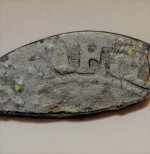
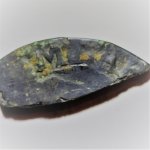
Kent Island was settled by Europeans in 1631 when Kent Fort was built on the southern tip of the island. Possession of the island fell into dispute and was taken over by the Calverts. The area was active in early trading being located along the Chesapeake Bay.
I was intrigued by this fragment and began working on the premise that it is a cut coin piece. Research of British and Spanish coinage soon eliminated those countries' coinage, as I found no matches with the stylistic features of the letters on the two sides of the fragment. I had a sense that the coin may be of Dutch origin and some fortuitous online research lead me to a likely match with the Netherland lion silver daalder, minted 1606 - 1697.
Below is an example of the obverse of a 1610 silver daalder and to its right the composite image of the fragment match to a 1623 daalder; match region is between 1 and 2 o'clock.

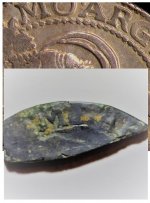
Similarly, here is a reverse of the 1610 daalder and alongside the fragment match to a 1623 version; match region is now between 2 and 3 o'clock.
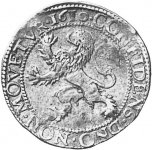
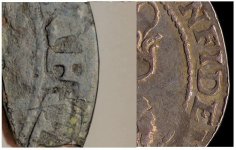
We are excited to have this early find that links the location to early European habitation and look forward to searching for more evidence.


Kent Island was settled by Europeans in 1631 when Kent Fort was built on the southern tip of the island. Possession of the island fell into dispute and was taken over by the Calverts. The area was active in early trading being located along the Chesapeake Bay.
I was intrigued by this fragment and began working on the premise that it is a cut coin piece. Research of British and Spanish coinage soon eliminated those countries' coinage, as I found no matches with the stylistic features of the letters on the two sides of the fragment. I had a sense that the coin may be of Dutch origin and some fortuitous online research lead me to a likely match with the Netherland lion silver daalder, minted 1606 - 1697.
Below is an example of the obverse of a 1610 silver daalder and to its right the composite image of the fragment match to a 1623 daalder; match region is between 1 and 2 o'clock.


Similarly, here is a reverse of the 1610 daalder and alongside the fragment match to a 1623 version; match region is now between 2 and 3 o'clock.


We are excited to have this early find that links the location to early European habitation and look forward to searching for more evidence.
Last edited:
Upvote
24






